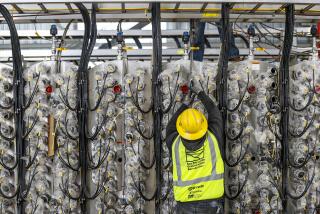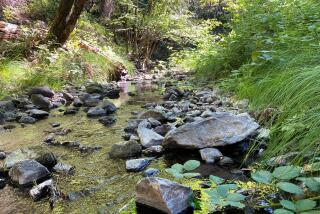Purifying Waste Water for Home Use Proposed
In what officials say would be the largest project of its kind in the world, water agencies are proposing to send highly purified waste water into the faucets of more than 2 million households in central and north Orange County.
The proposed $400-million Groundwater Replenishment System would treat about 40% of the water that households flush down their drains--and that now is pumped to the ocean--so that it becomes as pure as bottled water, officials say. It then would be pumped into the ground water basin and eventually withdrawn by water districts throughout north and central Orange County for household use.
“This project will put [the waste water] through a treatment process which will turn it into the highest-quality water available in Orange County,” said Thomas Dawes, who is managing the project for the Orange County Water District and Orange County Sanitation District.
Officials of the two districts acknowledge that residents could be squeamish about drinking water that used to be mixed with sewage. They will hold a public hearing Tuesday to explain the project and get public feedback, and they expect to vote on it in the spring.
District officials say the system is needed because of the county’s rapid growth. Within 20 years, 800,000 new residents are expected in North and Central County alone, creating demand for almost 50 billion additional gallons of water a year.
The water supplied by the project would be drawn out of the ground by districts spanning almost all of North and Central County, defined loosely as the area west of a line drawn from Yorba Linda to the western edge of Irvine. La Habra and Brea at the northern tip of the county are excluded because they are not part of the water district.
Without the project, the county would have to rely even more on water imported from the Colorado River and Northern California, sources that are more expensive and becoming increasingly restricted for environmental reasons, according to Ron Wildermuth, spokesman for the water district.
“That would be higher-priced water, so water bills would go up,” Wildermuth said. “If there were a drought, there could be a real problem.”
The water treatment process would pay for itself in reduced water and energy costs, he said.
While other water reclamation projects in the region have at times run into opposition from environmental and industry groups, this project has so far managed to steer clear of controversy.
In the San Gabriel Valley, for example, the Miller Brewing Co. and a group of local residents fought hard two years ago against a water reclamation project that would have put the treated waste water into the company’s beer, as well as sending it to other customers throughout the region. Opponents said the project provided inadequate protection for human health. Eventually the project was scaled down and modified, and located downstream of the brewery.
Forest Tennant, a former West Covina mayor who formed a citizens group to fight the San Gabriel project, said if water officials had proposed using the same technology Orange County wants to use, he would have supported it.
“That was the precise technology that we wanted them to use in the San Gabriel Valley, and they didn’t want to do that,” Tennant said. “That’s what the issue was all about.”
With Orange County’s technology, “it is very difficult for me to see how any viral particle or DNA particle would survive and be a threat to human existence,” Tennant added.
The Sierra Club, which has opposed a number of area water reclamation projects in the past, doesn’t have any major objections to this project, said Bob Siebert, chairman of the Conservation Committee of the club’s branch representing north and central Orange County. Although the group has yet to take a formal position on the project, Siebert said it appears beneficial--as long as the water quality is regularly monitored--because it preserves water resources.
Reed Royalty, president of the Orange County Taxpayers Assn., said he supports the project because it would not raise taxes or water rates. He also has no problem using water that at one time was considered sewage.
“A lot of people say, ‘No, I don’t want to drink water that’s been used before.’ The fact is, every drop of water on Earth has been used before. We have the same amount of water we’ve had since the days of the cave man, I suppose.”
The project’s environmental impact report is being reviewed by a number of government agencies.
Kurt Berchtold, assistant to the head of the Regional Water Quality Control Board, said the technologies to be used by the plant have proved effective.
“Generally, our agency supports proper waste water reuse as long as it’s done in a manner that protects both existing water quality and public health,” Berchtold said.
The system, which would be completed in stages from 2003 to 2020, would pump more than 32 billion gallons of purified water per year into the ground-water basin, which supplies about three-quarters of the tap water for northern and central Orange County. County officials hope to meet additional demand for water through conservation efforts such as distributing low-flush toilets and teaching efficient landscaping techniques, as well as importing more water.
South County imports all of its water and is therefore not affected by the project, while North and Central County import about one-quarter of their supply.
The technology used in the project is a relatively new combination of older techniques that has been used on a small scale in only a few communities throughout the country, according to county officials. Orange County would be taking a “leadership position” in the water industry by building this plant, said Dawes, the project manager.
The new plant in Fountain Valley would use microfiltration and reverse osmosis--essentially a two-part filtering process--and then sterilize the water with ultraviolet light. Minerals would be added back into the water to prevent concrete and iron in the pipes from leaching into it.
The purified water would be pumped from the plant to a pipeline along the Santa Ana River and dumped into the Kraemer Miller Basin in Anaheim to seep into the ground. From there, it would take at least two years before the first of the treated water is pulled out for household use.
Both microfiltration and reverse osmosis have been used in bottled water and in pharmaceuticals for years, but combining the two to produce clean tap water is a relatively new innovation, first used in 1992 by the Walt Disney Co. in Orlando, according to Wildermuth.
Districts in Los Angeles County and Arizona have been using the technology for several years without major problems, but their plants process only a fraction of the amount of water that Orange County would.
The techniques are so effective that officials believe they will eventually be able to desalinate ocean water cheaply. Desalination currently costs about four times as much as waste water to purify because of its high salt content.
“It’s a breakthrough industry that will probably become the standard in the dry, western parts of the United States in the next 10 to 20 years,” Dawes said.
*
A public hearing on the proposed project is scheduled for 6 p.m. Tuesday at Orange County Water District headquarters, 10500 Ellis Ave., Fountain Valley.
(BEGIN TEXT OF INFOBOX / INFOGRAPHIC)
From Your Drain to Your Faucet
Orange County’s water and sanitation districts are proposing a system that purifies treated wastewater to drinking water standards. The reclaimed water could supply 800,000 people a year in North and Central County. How it works:
1. Water leaves home through the sewer system.
2. It is pumped to a sanitation plant and treated to a level that makes it safe for oceans and streams.
3. Under the current method, treated water is piped to the ocean.
4. With the new system 40% of the water is instead filtered using microfiltration and reverse osmosis and sterilized by ultraviolet light. Minerals are added to prevent it from picking up iron and other minerals from the pipes. Chlorine is added as an extra disinfectant.
5. The clean water is pumped along the Santa Ana River to a holding basin in Anaheim. From there, it percolates into the ground water and spreads throughout north and central Orange County.
Source: Orange County Water District
More to Read
Sign up for Essential California
The most important California stories and recommendations in your inbox every morning.
You may occasionally receive promotional content from the Los Angeles Times.










